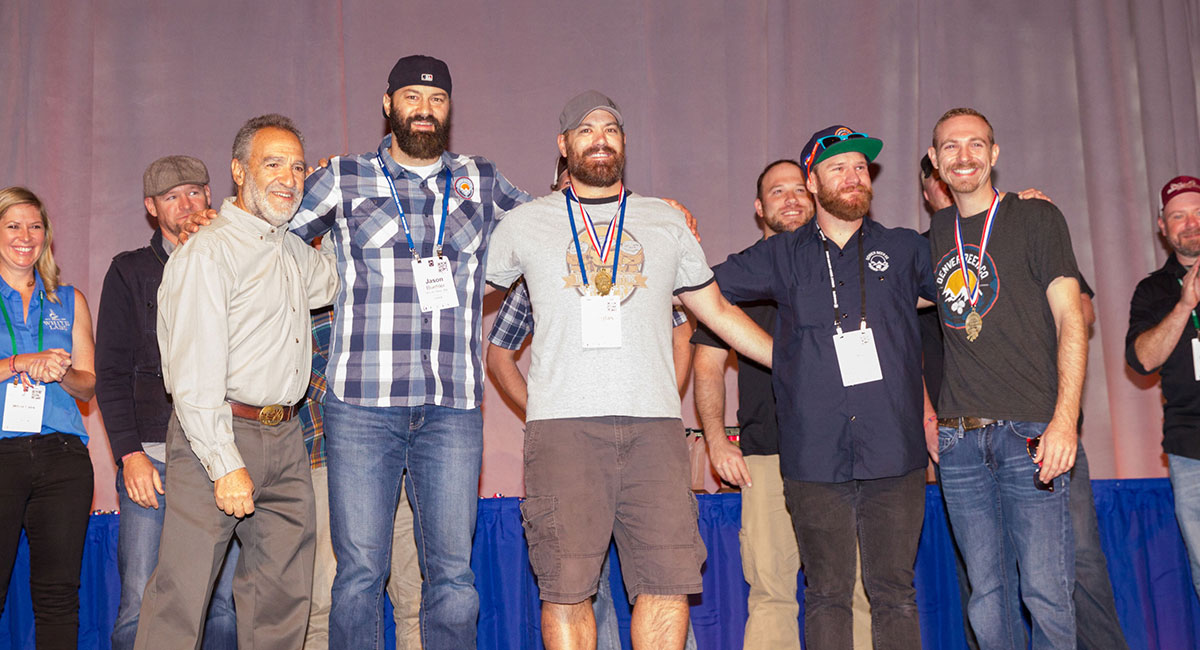
The National Homebrew Competition (NHC) styles are determined by the AHA Competition Subcommittee using the Beer Judge Certification Program’s 2015 Style Guidelines and previous years’ data. The following is a list of BJCP subcategories reorganized from the BJCP’s 2015 Guidelines into NHC Styles. NHC Styles are listed in bold, while BJCP subcategories falling within NHC styles are listed beneath.
Entries entered in the following 2015 Beer Judge Certification Program (BJCP) subcategories will require specialty information and instructions: 7C, 9A, 10C, 21B, 23F, 24C, 25B, 27J, 28A, 28B, 28C, 29A, 29B, 29C, 30A, 30B, 30C, 31A, 31B, 32A, 32B, 33A, 33B, 34A, 34B, 34C, 35A, 35B, 35C, 36A, 36B, 36C, 36D, 36E, 37A, 37B, 38A, 38B, 38C, 39A, 39B, 39C, 39D, 39E, 40A, 40B, 40C, 40D, 40E, 40F.
*Special Ingredients Required
Pale American Beer
1A. American Light Lager
1B. American Lager
1C. Cream Ale
1D. American Wheat Beer
18A. Blonde Ale
Pale European Beer
2A. International Pale Lager
4A. Munich Helles
5A. German Leichtbier
5B. Kölsch
5C. German Helles Exportbier
Pilsner
3A. Czech Pale Lager
3B. Czech Premium Pale Lager
5D. German Pils
27F. Pre-Prohibition Lager
Amber European Beer
2B. International Amber Lager
3C. Czech Amber Lager
6A. Märzen
7A. Vienna Lager
7B. Altbier
7C. Kellerbier*
Dark European Lager
2C. International Dark Lager
3D. Czech Dark Lager
8A. Munich Dunkel
8B. Schwarzbier
Bock
4C. Helles Bock
6C. Dunkles Bock
9A. Doppelbock*
9B. Eisbock
9C. Baltic Porter
German Wheat Beer
10A. Weissbier
10B. Dunkles Weissbier
10C. Weizenbock*
27H. Roggenbier
27I. Sahti
Pale British Ale
11A. Ordinary Bitter
11B. Best Bitter
11C. Strong Bitter
12A. British Golden Ale
12B. Australian Sparkling Ale
12C. English IPA
Scottish & Irish Ale
14A. Scottish Light
14B. Scottish Heavy
14C. Scottish Export
15A. Irish Red Ale
American Pale Ale (18B)
Amber & Brown American Ale
19A. American Amber Ale
19B. California Common
19C. American Brown Ale
27B. Kentucky Common
Brown British Beer
13A. Dark Mild
13B. British Brown Ale
13C. English Porter
27D. London Brown Ale
British & Irish Stout
15B. Irish Stout
15C. Irish Extra Stout
16A. Sweet Stout
16B. Oatmeal Stout
16C. Tropical Stout
16D. Foreign Extra Stout
American Porter & Stout
20A. American Porter
20B. American Stout
27G. Pre-Prohibition Porter
Imperial Stout (20C)
American IPA (21A)
Specialty IPA (all)* (21B)
Strong American Ale
22A. Double IPA
22B. American Strong Ale
22C. American Barleywine
22D. Wheatwine
Strong UK Ale
17A. English Strong Ale
17B. Old Ale
17C. Wee Heavy
17D. English Barleywine
Saison (25B)*
Belgian Ale
24A. Witbier
24B. Belgian Pale Ale
24C. Biere de Garde*
25A. Belgian Blond Ale
26A. Trappist Single
34A. Clone Beer (Belgian Styles)
Strong Belgian Ale
25C. Belgian Golden Strong Ale
26B. Belgian Dubbel
26C. Belgian Tripel
26D. Belgian Dark Strong Ale
European Sour Ale
23A. Berliner Weisse
23B. Flanders Red Ale
23C. Oud Bruin
23D. Lambic
23E. Gueuze
23F. Fruit Lambic*
27A. Historical: Gose
Fruit Beer
29A. Fruit Beer*
29B. Fruit and Spice Beer*
29C. Specialty Fruit Beer*
Spiced Beer
30A. Spice, Herb, or Vegetable Beer*
30B. Autumn Seasonal Beer*
30C. Winter Seasonal Beer*
Smoke-Flavored & Wood-Aged Beer
6B. Rauchbier
27C. Lichtenhainer
27E. Piwo Grodziskie
32A. Classic Style Smoked Beer*
32B. Specialty Smoked Beer*
33A. Wood-Aged Beer*
33B. Specialty Wood-Aged*
American Wild Ale
28A. Brett Beer*
28B. Mixed Ferm. Sour Beer*
28C. Soured Fruit Beer*
Specialty Beer
31A. Alternative Grain Beer*
31B. Alternative Sugar Beer*
34D. Clone Beer (non-Belgian)*
34B. Mixed-Style Beer*
34C. Experimental Beer*
27J. Other Historical Beer*
Traditional Mead
35A. Dry Mead*
35B. Semi-Sweet Mead*
35C. Sweet Mead*
Fruit Mead
36A. Cyser*
36B. Pyment*
36C. Berry Mead*
36D. Stone Fruit Mead*
36E. Melomel*
Spice & Specialty Mead
37A. Fruit & Spice Mead*
37B. Spice, Herb, Vegetable Mead*
38A. Braggot*
38B. Historical Mead*
38C. Experimental Mead*
Standard Cider & Perry
39A. New World Cider*
39B. English Cider*
39C. French Cider*
39D. New World Perry*
39E. Traditional Perry*
Specialty Cider & Perry
40A. New England Cider*
40B. Cider with Other Fruit*
40C. Applewine*
40D. Ice Cider*
40E. Cider with Herbs/Spices*
40F. Specialty Cider/Perry*
The post 2018 National Homebrew Competition Styles appeared first on American Homebrewers Association.

![]()



